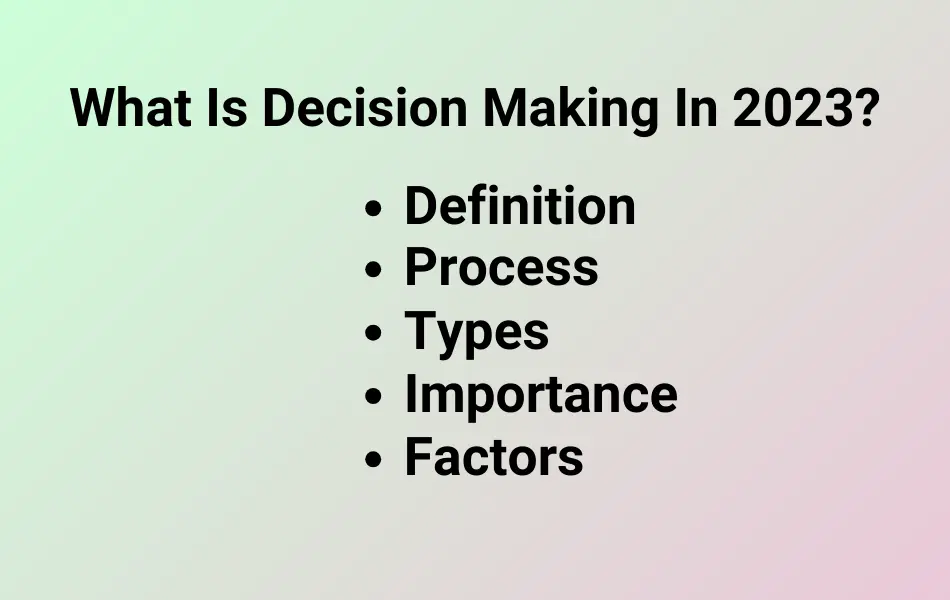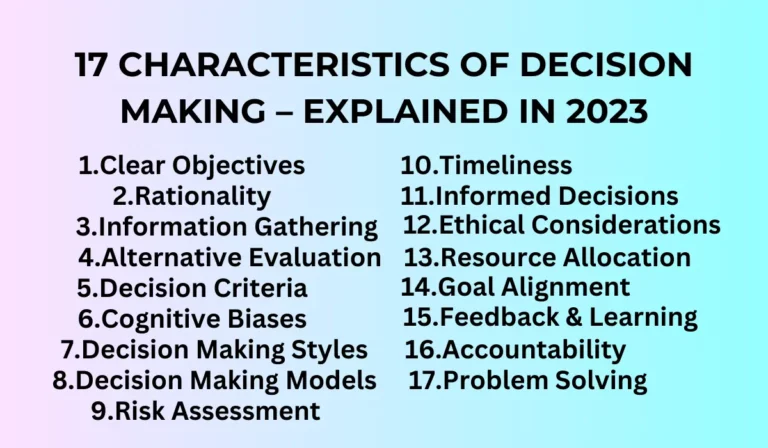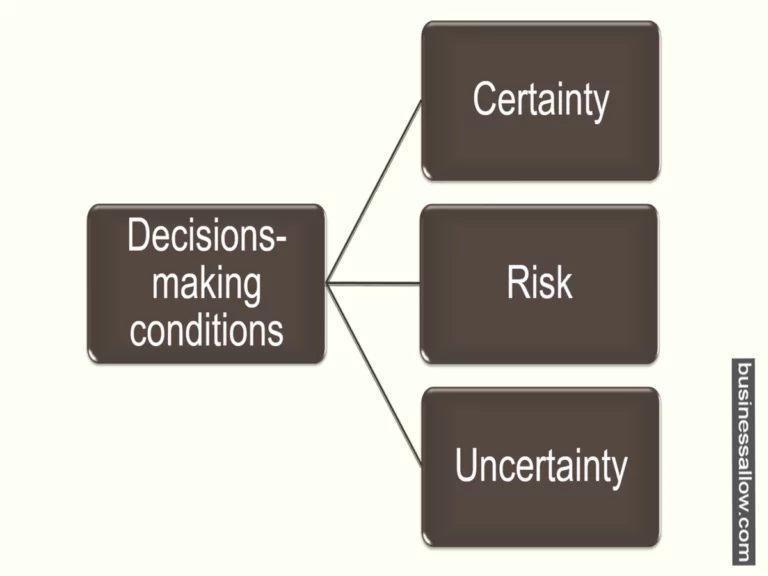What is Decision Making In 2024? Definition, Process, Types, Features, Importance, Factors

What Is Decision Making?
Decision Making refers to the process of choosing between multiple courses of action. It’s a step-by-step procedure that involves identifying a problem, analyzing solutions, and selecting the most suitable one.
Content Outline
Objective of Decision Making
- The main objective of decision making in business is to achieve optimal results and improve the organization’s overall performance.
- It helps maximize profits, minimize costs, and allocate resources effectively.
- Decision making supports strategic planning, allowing businesses to adapt to changes in the market and remain competitive.
- It facilitates problem-solving, allowing businesses to overcome challenges and seize opportunities.
- Decision making encourages innovation and fosters growth and development within the organization.
- It enables effective risk management by identifying potential risks and uncertainties and developing appropriate mitigation strategies.
- Decision making promotes effective communication and collaboration among team members, fostering a culture of teamwork and shared responsibility.
9 Types of Decision Making
- Programmed Decisions: These are routine decisions made daily. They’re based on set guidelines or procedures. Examples include deciding the office lunch menu or the route to work.
- Non-Programmed Decisions: These are unique and require careful thought. They arise in unanticipated situations. For instance, they decide to launch a new product or expand a business.
- Strategic Decisions: They shape the organization’s long-term plans. Defining a new goal or changing the business model are examples.
- Operational Decisions: These are short-term decisions related to the company’s daily operations. Deciding employee shifts or purchasing office supplies falls into this category.
- Formal Decisions: These are decisions made within a structured and predefined process, often involving official documentation, protocols, and established rules. Examples include decisions made in legal proceedings, board meetings, or government policies.
- Informal Decisions: Unlike formal decisions, informal decisions are more spontaneous and less structured. They are often made on the spot, without proper documentation or established procedures. Informal decisions are typically made in casual settings or daily life, such as choosing what to wear or where to have lunch.
- Group Decisions: Group decisions involve the participation of multiple individuals who collaborate and share their perspectives to reach a consensus. Group decision making can benefit from diverse input, viewpoints, and shared responsibility. It is commonly used in team-based work environments, group discussions, and brainstorming sessions.
- Individual Decisions: Individual decisions, as the name suggests, are made by a single person, usually without direct input or collaboration from others. These decisions rely solely on the individual’s knowledge, experience, preferences, and judgment. Examples include personal choices like deciding on a career path or hobby.
- Autocratic Decisions: Autocratic decision making is characterized by a single individual making decisions without seeking input or considering the opinions of others. This type of decision making often occurs when someone has the authority or expertise to make decisions independently. It can be effective in situations where quick and decisive action is necessary.
Related: features of decision making
Factors Affecting Decision-Making
Various internal and external factors impact decision-making.
Personal Bias:
Personal preferences and prejudices can influence decision making. It can lead to favoritism or bias in decision outcomes.
Lack of Information:
Limited or no information about a situation hinders the decision-making process, as making a logical choice becomes challenging.
Time Pressure:
Limited time can cause rushed decisions, often leading to less-than-optimal outcomes.
Decision Complexity:
Complex decisions with multiple interrelated factors make the decision-making process more challenging.
Organizational Culture:
The culture and policies of an organization can influence decision-making processes and outcomes.
Steps in the Decision Making Process – Top 6
Step#1. Identification of the Problem
The first step in the decision-making process is identifying the problem or opportunity that requires a decision. By doing so, you set up the foundation of the entire process, as you can only decide once you define the issue at hand. With a clear statement of the problem or opportunity, you may avoid making an incorrect decision or a choice that produces unintended consequences.
Step#2. Gathering of Information
Once you have identified the problem or opportunity, you need to have a solid understanding of it. Gathering information involves seeking relevant data, perspectives, and expert opinions. It helps you make an informed decision rather than a haphazard or bias-driven one. With enough information, you can see things from different angles and choose the most effective and efficient solution.
Step#3. Evaluation of Options
The next step is to evaluate possible options or alternatives based on the information collected. When we work towards a solution, it’s natural for our minds to generate several possible alternatives. In the evaluation of options step, you apply criteria to compare and contrast possible solutions and their impact. This saves time, resources, and effort and helps us achieve a suitable and successful outcome.
Step#4. Selection of the Best Alternative
Once you have evaluated the options, it’s time to select the best alternative. This is a critical step, as the effort put into the previous actions will only count when you put it into practice. A well formed selection ensures that the implementation of the decision is correct and produces the desired result. After selecting the best, you should also develop a plan for implementing it.
Step#5. Implementation of the Decision
The implementation of the decision is the point at which you turn the theory into practice. This stage involves putting the chosen solution into action. It’s essential to follow through with your plans accurately and adequately and ensure everybody knows the changes. Communication is vital during this phase; you must handle any barriers efficiently.
Step#6. Monitoring and Evaluation of the Decision
Finally, once the decision is established, you should monitor and evaluate its outcomes. It helps you realize whether the decision succeeded and achieved the intended goals. Regular checks and analysis can uncover required issues so you can make necessary adjustments. It also contributes to future decision-making, allowing you to fine-tune your process and make more effective decisions.
Decision Making Models and Theories
Model#1. Rational Decision Making Model
The Rational Decision Making Model breaks down decisions into a process with defined steps. It includes identifying the decision to be made, gathering relevant information, identifying alternatives, weighing evidence, choosing other options, taking action, and finally reviewing the decision and its consequences.
Model#2. Bounded Rationality Model
The Bounded Rationality Model proposed by Herbert Simon accommodates realities of limited information and cognitive limitations. According to this model, individuals make decisions based on the most readily available data rather than reviewing all possible alternatives.
Theories:
Theory#1. Prospect Theory
The Prospect Theory, developed by Kahneman and Tversky, states that people make decisions based on the potential value of losses and gains rather than the outcome. This theory explains why people take risks when they face adverse effects and avoid risks when facing positive results.
Theory#2. Behavioral Theory
Lastly, the Behavioral Theory emphasizes that decisions are sometimes made rationally or logically. It underlines how personal behaviors, biases, and social influences impact decision-making. This theory often elaborates on the irrational behaviors exhibited by individuals while making decisions.
These models and theories paint a comprehensive picture of decision-making, highlighting the roles of logic, mental boundaries, perceived gains and losses, and behavior in shaping our judgments.
Related: Decision Making Models
Approaches to Enhance Decision Making
1. Analytical Thinking
Analytical thinking involves breaking down complex problems into smaller components and analyzing them systematically. By utilizing logical reasoning and data-driven methods, individuals can make more informed decisions based on evidence and facts. This approach emphasizes critical thinking skills and objectively evaluating different options.
2. Creative Thinking
Creative thinking encourages individuals to explore unconventional solutions and think outside the box. It involves generating new ideas, challenging assumptions, and considering alternative perspectives. By embracing creativity, decision-makers can uncover innovative solutions that may be absent through traditional analytical approaches. Creative thinking allows for greater flexibility and adaptability in decision making.
3. Group Decision Making
Group decision making involves gathering input and insights from multiple individuals to arrive at a collective decision. By leveraging the diverse knowledge, skills, and perspectives of a group, decision making can be enriched. Group members can challenge each other’s assumptions, provide different viewpoints, and contribute to a more comprehensive evaluation of the options. Collaboration and effective communication are key in this approach.
4. Artificial Intelligence
Artificial Intelligence (AI) has the potential to enhance decision-making by analyzing vast amounts of data, identifying patterns, and providing valuable insights. AI algorithms can process complex information quickly and accurately, allowing for data-driven decision-making. Machine learning models can also predict outcomes based on historical data, aiding in risk assessment and scenario analysis. It is important to note that AI should be utilized in conjunction with human judgment and ethical considerations.
These approaches provide a well-rounded perspective, increase problem-solving capabilities, and enable more effective decision-making in various aspects of life.
Conclusion
In conclusion, we can say that decision making is a problem solving tool for organizations and businesses and ensures successful outcomes by selecting a single option from different alternatives.






